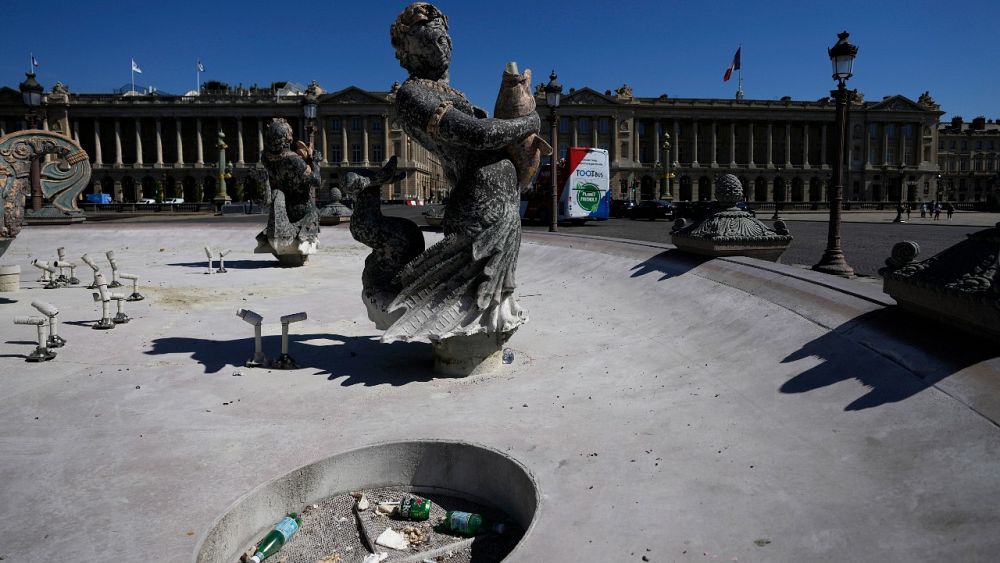‘Nothing left in the pipes’: Europe tackles unprecedented water shortages as heatwave rages

The French government has set up a crisis team to tackle a historic drought that has left more than 100 municipalities short of drinking water.
Trucks are taking water to those areas, as “there is nothing left in the pipes”, Minister for Ecological Transition Christophe Béchu said. “This is a situation like nothing we’ve ever seen… And the bad news is that, as far as we can see, there’s no reason to think that it will stop.”
Prime Minister Elisabeth Borne has warned that France is facing the “most severe drought” ever recorded in the country.
The heatwave that has baked the country since June has prompted trees and bushes to shed their leaves early, creating scenes that look autumnal.
After a cooling off in some regions, the French national meteorological service Météo-France is forecasting further increases in temperatures from Sunday onwards and still drier soil despite recent storms.
Temperatures well above 30 degrees Celsius and rising to as high as 37°C in parts of the south are forecast from Sunday and over the next few days.
“Maximum temperatures between 32°C and 36°C could very probably remain for a long time over a large part of the country,” said Météo-France.
In Rome, residents and tourists cooled off at the many water fountains dotted across the city.
Popular tourist destinations in Italy such as Florence and Palermo are among 16 Italian cities on the “red alert” list, with temperatures topping 40°C.
Rice production in the river Po Valley is under severe threat as drought and hot weather continue to cause paddy fields to completely dry up and become salty from use of aquifers.
Farmers say harvests of the rice used for risotto could be damaged for years by the increased salt content in the earth, which is killing off plants.
Part of a €17 billion package of government measures to tackle the cost-of-living crisis in Italy is also aimed at mitigating the effects of the drought, the worst for 70 years in the country.
Last month Italy’s agriculture minister warned Parliament that a third of Italy’s agricultural production was at risk because of drought and poor water infrastructure, and that the situation is only going to get worse in years to come.
Dutch Minister of Infrastructure and Water Management Mark Harbers has called on people to shower quicker and not to wash their cars or water the garden.
Houseboat owners in Arnhem say the difference between the summer and winter water levels is so great that the boats are lying at an angle.
The Netherlands on Wednesday declared an official water shortage, having already imposed limits on agriculture and shipping.
The government warned that the drought is expected to “continue for some time” and further measures to conserve water during the drought were being considered — while assuring that sufficient drinking water remains available.
The country is protected from water by a famous system of dams, dikes and canals, but with about a third of its land area below sea level, it remains particularly vulnerable to climate change.
Some regions of the Netherlands, the world’s second-largest agricultural exporter after the United States, have already banned farmers from watering their crops with surface water. Some canal locks for navigation have been closed.
Priority would now be given to the safety of the Dutch dyke system, followed by drinking water and energy supplies, according to the government.
Water levels on the Rhine in Germany have also continued to fall in the hot weather. Shipping costs have risen because vessels cannot sail on the river fully loaded, vessel brokers said on Friday.
Freight shipping on the river continues but with vessels sometimes forced to sail 75% empty. “Customers would often need three vessels to transport their cargo instead of one,” said Roberto Spranzi, director of the DTG shipping cooperative.
Shipping capacity is already tight because of increased demand after Germany’s move to increase coal-fired electricity generation as it braces for reduced gas supplies from Russia, Spranzi added.
Low Rhine water will also hit output from two German coal-fired power stations in the coming months.
In Romania, water levels on the Danube have dropped so much that sand islands surfaced in the Calafat region. The Danube levels are now close to their all-time low.
The government plans to increase investment in irrigation projects to limit crop damage in the future.
On Wednesday the European Commission called on member states to re-use treated urban waste water for agricultural irrigation.
Other parts of Europe have also witnessed torrid conditions in the early summer.
Portugal last month recorded its hottest July since records began in 1931, the country’s weather service IPMA said on Friday.
The heat worsened Portugal’s drought, with 45% of the mainland in “extreme drought” — the highest classification — and the rest in “severe” drought, which is the second-highest, by the end of July.
The average temperature was 25.14°C, the IPMA said, almost three degrees Celsius higher than the expected July average. National rainfall measured 3 millimetres, around 22% of the normal amount.
